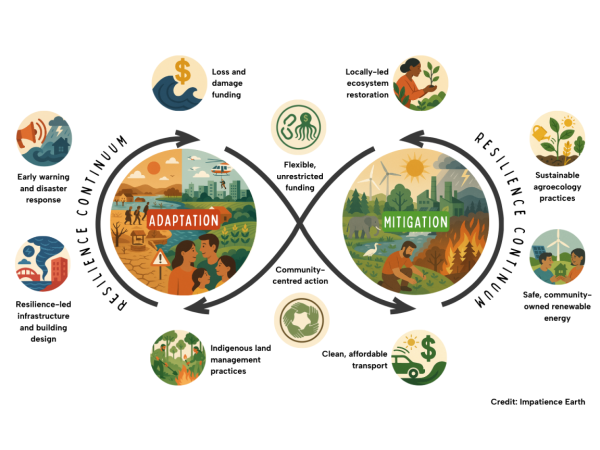Beyond the mitigation-adaptation binary: How funders can embrace the Resilience Continuum
Beyond the mitigation-adaptation binary: How funders can embrace the Resilience Continuum
Philanthropy is society’s most flexible capital. It can be deployed quickly, take risks, and hold businesses and governments to account. With the catastrophic impacts of the climate crisis closing in, flexible climate philanthropy has never been more needed.
To date, the majority of philanthropic funding for climate has been mitigation-focused, aimed at preventing climate change from worsening or seeking to reverse its effects. In 2023, it was estimated that of the $9.3–$15.8 billion in philanthropic giving for climate action, only about $600 million (less than seven percent) was directed towards adaptation and resilience initiatives. Focusing climate funding solely on mitigation made sense ten years ago. And funders can be forgiven for feeling overwhelmed and unsure which actions to take – especially as climate change is one of several existential threats to a humanity facing polycrisis. But the stakes are too great to put everything we can into the solution.
Our recommendation: embrace the Resilience Continuum.

What is the Resilience Continuum
The Resilience Continuum, a term coined by Shehnaaz Moosa, refers to the spectrum of work that communities and leaders across the world are doing on a daily basis – and particularly in the Global South where climate change impacts are felt most acutely. It also offers a framework for all actors to engage with the multiple threats to resilience.
The Resilience Continuum ranges from immediate coping mechanisms to long-term transformative strategies. This continuum acknowledges that resilience is not a static state but a dynamic process involving various capacities and allowing for more nuanced and effective interventions.
Resilience can be:
- Anticipative — anticipating that change might happen
- Absorptive — withstanding shocks
- Adaptive — making incremental adjustments
- Transformative — effecting systemic change.
To give a few examples: funding can initiate early warning systems, support immediate relief efforts (such as after a flood), while also promoting long-term projects that foster adaptive learning and systemic transformation, like sustainable agroecological practices at scale or policy advocacy for supporting women-led landscape restoration efforts.

At the heart of building true resilience, are the voices and capacities of communities. Unsurprisingly, communities have unmatched insight into what is needed to help build resilience. The resilience continuum emphasises empowering communities to identify their own vulnerabilities and strengths, ensuring that interventions are contextually relevant, locally-led and sustainable. Building true resilience involves enhancing the inherent capacities of communities to navigate and shape their own futures.
Why is this important?
The Resilience Continuum can help funders to avoid falling into the ‘mitigation vs adaptation’ binary – the trap that leads people to feel they must focus on their specific ‘theme’ and avoid detracting from their core mission. Given the intersection and interconnectedness of the polycrisis, funders that are currently reconsidering their strategies should embrace resilience thinking – not as a departure from their mission, but as a framework that enhances it.
Philanthropic funding has an important role to play in supporting non-economic loss and damage, as this is an area that is often overlooked by government and multilateral investments. Adopting a resilience framing for funding allows us to go beyond the mitigation-adaptation binary and proactively consider and address these often intangible yet critical impacts.
Other critical areas that are often overlooked in climate funding strategies include: strengthening indigenous knowledge systems for sustainable resource management, integrating an intersectionality lens by considering gender, age and disability into planning, fostering local entrepreneurship in circular economies, or strengthening community-based disaster preparedness networks – all actions that build holistic resilience from the ground up. These kinds of activities, informed and led by trusted members of the community, have a greater chance of outlasting any political or economic upheaval, which is something that funders are increasingly concerned by.
The ongoing, long-term nature of the resilience continuum is also important to emphasise. In addition to philanthropic resilience funding being able to fill gaps (e.g. non-economic loss and damage), and support community-led interventions that last, this type of capital can also act as a bridge for other funders. Financing resilience goes beyond funding one-off projects and instead requires an ongoing and coordinated effort to ensure action across different stages of the continuum, thereby ensuring the sustainability and consistency of resilience funding.
What does this look like in practice?
Locally-led adaptation and resilience on Santo Island, Vanuatu
Santo Island is the largest and most remote part of the archipelago country of Vanuatu in the South Pacific. Areas of the island are at high risk of sea level rise and face increasing threats of cyclones, storm surges, landslides, flooding, and droughts.
The Santo Sunset Environment Network (SSEN) is an Indigenous-led network of community champions working for climate-resilient and socially just development on the island. Supported by funders including the Honnold Foundation, SSEN is a network with over 250 volunteers, representing the interests of 42 communities on the west and northwest coasts of Santo Island.
Among a range of activities, SSEN has a Women’s Environment Network that is active across all 42 communities. It hosts workshops on kitchen gardening using indigenous crops that can weather adverse conditions, small business skills for weavers and soap makers to establish cooperatives, and provides locally tailored climate change adaptation training. This is particularly important as it is typically women in the community who look after the gardens, source food from the forest and the coral reefs, and who care for the elderly and children who are most at risk to climate hazards.
Empowering youth through flood risk mapping in Niamey, Niger
In Niamey, Niger, local youth have been trained as ‘investigators’ to map flood-prone areas using smartphones and highlight areas and buildings at risk where disaster relief and adaptation can be prioritised. This participatory approach enhanced the community’s anticipatory and absorptive capacity by identifying immediate risks and informing targeted interventions. Beyond immediate risk mitigation, the project fostered adaptive capacity by equipping youth with technological skills and knowledge in disaster risk management. The project cultivated a culture of proactive community engagement and empowered young individuals to take leadership roles in resilience-building efforts.
Integrating gender-transformative approaches in Burkina Faso
The Zaman Lebidi project in Burkina Faso aimed to strengthen community resilience by addressing entrenched gender norms. Traditionally, women in these communities had limited decision-making power and access to resources. The project introduced initiatives that encouraged women’s active participation in community discussions and decision-making processes through women-led listening groups, during which climate information was communicated. For instance, women were also supported to own and manage livestock, a role traditionally reserved for men. This shift not only improved household incomes but also began to transform societal perceptions of gender roles. By fostering an environment where women could voice their opinions and take on leadership roles, the project facilitated transformative change, enhancing the community’s overall resilience to climate extremes.
Women-led seaweed farming in Tanzania
Tanzania’s coastal communities, especially on the shores of Zanzibar, face mounting climate risks, from rising sea temperatures to unpredictable weather that are threatening seaweed farming – a vital source of income and a carbon sink of growing importance. Women make up 88 percent of seaweed farmers, yet they are particularly vulnerable due to reliance on shallow-water methods, which are more exposed to disease and heat stress.
In response, the Aqua-Farms Organisation with philanthropic support from the Ocean Risk and Resilience Action Alliance launched a rent-to-own microcredit model enabling women’s cooperatives to access deep-water farming equipment. This method reduces crop die-off and boosts harvests. Paired with training in best practices and value-added production (e.g. soaps and cosmetics), the initiative has more than doubled average monthly incomes and enhanced women’s agency.
Seaweed farming has become not just a livelihood but a platform for empowerment and climate resilience. By combining traditional knowledge with tailored finance and innovation, Tanzania’s ‘seaweed women’ are leading locally led adaptation from the frontlines.
Here’s how philanthropy should look ahead
In a world marked by compounding crises, it is now imperative that philanthropy is alert to our shifting realities and evolves to meet the moment. Philanthropic capital is responsive, flexible, creative, and uniquely placed to meet these demands. Breaking out of the adaptation vs mitigation binary – out of the immediate vs long-term approach that corrals us towards static solutions – is part of the wider shift needed. Here are some of the practical shifts funders can make:
Update your funding practices
Funders can offer unrestricted funding, giving organisations greater control over spending. In this way, funding defers to the expertise of those working within the communities and action needed by communities themselves. Equally, funders can adopt greater flexibility in allowing grant recipients to pivot the activities of their work. This is needed whether funding is unrestricted or otherwise. In this way, communities can better navigate changes as they arise. Unlocking this may be as simple as making approval processes faster or even removing them altogether.
Apply the Resilience Continuum to your strategy
Funders can adopt a funding approach which shifts focus away from funding issue areas in siloes, to one that focuses on funding the needs of the community. This might include education, water sanitation and hygiene, supporting the arts – all with a climate resilience lens. Funders can also connect with peers to ensure that grant funding is complementary: this ensures action is taken across different stages of the resilience continuum (from early warning to long-term transformation) rather than fragmented, duplicate, one-off interventions.
Look for implementation partners that are led by, or centre communities
Funders should find implementation partners that devolve decision-making to the lowest appropriate level. In doing so, funders are championing practices that centre community-led and informed action to ensure that resilience-building work has the greatest chance of long-term success.
Connect with others
Community is important, including within the philanthropic arena. Joining others helps share learning, strengthen responses and ramp up momentum. Organisations like Impatience Earth and SouthSouthNorth are here to help: if you or an organisation you know would like to join a cohort of funders to explore ways to power up your impact on climate resilience, click here to learn more and express your interest. Subject to demand, Impatience Earth and SouthSouthNorth will curate a journey that takes funders from learning that is grounded in lived and subject expertise to peer exchange and support to action.
As our world is increasingly shaped by rapid change and overlapping challenges, funders have both the opportunity and the responsibility to reimagine their role and reimagine our future. As Prime Minister of Barbados, Mia Mottley, has said many times, ‘if we could send a man to the moon…we surely can find the solutions to the climate crisis.’
This article was originally published in Alliance Magazine, and can be read here.
